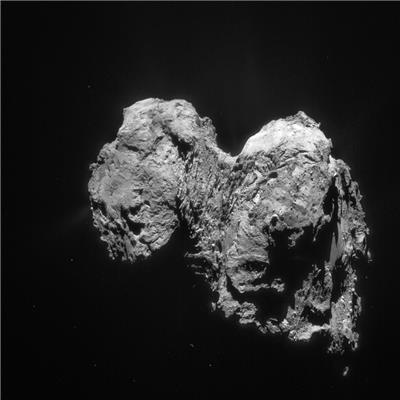

| Online: | |
| Visits: | |
| Stories: |

| Story Views | |
| Now: | |
| Last Hour: | |
| Last 24 Hours: | |
| Total: | |
Comet Chury Is Much Younger Than Previously Thought
Based on computer simulations, Astrophysicists at the University of Bern, Switzerland, conclude that the comet Churyumov–Gerasimenko a.k.a. “Chury” did not obtain its duck-like form during the formation of our solar system 4.5 billion years ago. Although it does contain primordial material, they are able to show that the comet in its present form is hardly more than a billion years old.
Based on data from the Rosetta space probe, scientists have so far assumed that the comet 67P/Churyumov–Gerasimenko originated from the initial phase of our solar system. Its peculiar, duck-shaped structure would have resulted from a gentle collision of two objects about 4.5 billion years ago.
If the assumptions of the present “standard” model of the origin of our solar system are correct, a quiet initial phase was followed by a period in which large bodies initiated higher velocities and more violent collisions. In a first study, the scientists calculated how much energy would be needed to destroy a structure like Chury in a collision.
The new study shows that comets like Chury experienced a significant number of collisions over time, the energy of which would have been sufficient to destroy a bi-lobe structure. Therefore, the shape is not primordial, but has developed through collisions over billions of years. “Chury’s present shape is the result of the last major impact which probably occurred within the last billion years,” says Martin Jutzi.
New shape, same content
In the second paper, Jutzi and Benz investigate exactly how Chury’s current form could have resulted from a collision. In their computer models, they had small objects with a diameter of 200 to 400 meters crashing into a roughly five-kilometre, rotating body in the form of a rugby ball (see animation). The impact speed was in the range of 200 to 300 meters per second, which clearly exceeds the escape velocity for objects of this size (about 1 meter per second).
Does the result of this research contradict previous knowledge that comets consist of primordial material at least as old as our solar system? “No,” the researchers say. Their computer simulations show that the relatively small impact energy does not heat or compress the comet globally. The body is still porous and the volatile material which was contained in it since the beginning is retained. In connection with Chury, these properties could be measured convincingly with the space probe Rosetta. “So far, it has been assumed that comets are original building blocks – similar to Lego,” says Willy Benz. “Our work shows that the Lego blocks no longer have their original form, but the plastic that they consist of is still the same as in the beginning.”
M. Jutzi et al.: How primordial ist the structure of comet 67P/c-G?, Astronomy & Astrophysics, 9. November 2016, http://arxiv.org/abs/1611.02604
M. Jutzi, W. Benz: Formation of bi-lobed shapes by sub-catastrophic collisions – A late originin of comet 67P/C-G’s structure, Astronomy & Astrophysics, 9. November 2016, https://arxiv.org/abs/1611.02615
Source:



